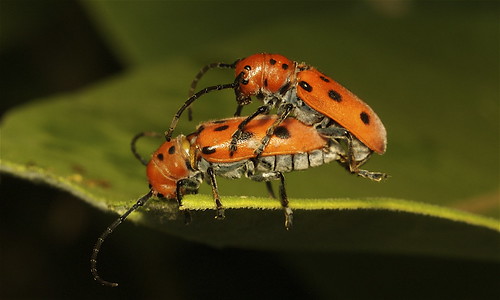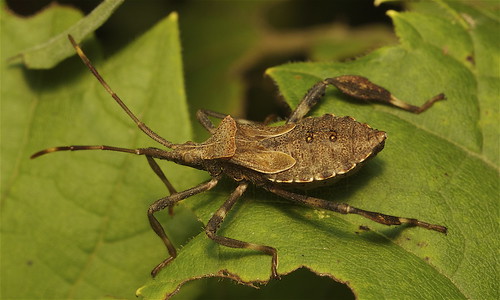Black-spotted red beetles are photogenic. Mating ones even more so. I was happy to find them, but the female seemed to be pretty unimpressed with the mating thing, preferring to focus her attention on eating, which is probably wise, given that she would need shortly to be producing and laying eggs. The male is determined, but looks a bit ridiculous.
Wednesday, August 01, 2007
Feeding katydid
This katydid was nonplussed at my presence and by the repeated photographs I took of it. I was pleased to capture it eating, pleased that it was eating from a beautiful chicory flower, and pretty pleased with how this photograph came out. On Safari, my current favourite browser, the colours and tone come out rich and well balanced. On Firefox and IE, browsers lacking ICC profile detection and associated rendering support, this photograph looks a bit overexposed and not so rich in colour.
Leaf-footed bug - Acanthocephala terminalis
Here's a fun bug, large for Ontario. It's a Leaf-footed bug, one of a large variety of related bugs that suck juices from plants. It's a bug in the truest sense of the word, being of the sub-order Heteroptera, having a sucking part, six legs, and other features, along with having a nymph phase rather than a true metamorphosis.
I had a bit of a hard time getting good shots of this individual. In typical avoidance fashion, it kept on moving away from the camera, hiding on the underside of the leaf. At this small scale, gravity is less of a consideration, certainly less of a hindrance.
Pennsylvania Ambush bug - Phymata sp.
Another use of bright and strong colour, though not as successful as with the Long-horned bees. I think this one doesn't work as well because the balance of bright and dark tends here too much to the bright.
Ambush bugs are very tricky to photograph, both because they are very very well camouflaged and because it's tricky, when photographing them, to know when you are in focus. I think this is because the eyes, which I normally use as my focal point, are soft and flat in colour, unlike the rest of their body, which is angular and rough and stippled. This photograph worked out well enough because I was able to get good focus on the head and shoulders and because the pale green of the bug contrasts with the orange-yellow of the flower. I made it a bit cooler to bring out the green.
If I ever went into entomology I might enjoy studying exactly how insects go about making themselves more difficult to see, beyond the obvious colour camouflage and not moving. I think it may turn out that some new ways are still to be found whereby insects take advantage of how the visual system of an observer works to make it more difficult to get a visual 'lock'.
Together briefly
This photo of two Long-horned bees mating on a flower is one of my favourite invertebrate photos in a while. It was taken offhandedly, though with carefully checked exposure, at the main building of the Royal Botanical Gardens in Hamilton.
I love the deep, rich colour and the fact that it draws the bees into the scene. The richness of tones reminds me of those one sees in Rembrandt paintings, tending towards the dark, but not too much to obscure. Rembrandt paintings, when I was young, used to strike me as too dark and sombre, but now, as I try to learn more about colour and tonal ranges, I tend to admire this sort of thing more. Perhaps doing strong tones while still allowing lighting in a scene to work so very well was Rembrandt's way of showing off.
Surfing Safari
 Though I may change my mind on this, I am switching from using Firefox to Safari as my browser of choice. Most of the reasons for this relate to aesthetics and colour handling. Safari, on my iMac, is generally more responsive and smooth than Firefox. Copied text in Safari has its formatting preserved, making the loss of the Aardvark plugin easier to live with. Passwords get saved in the system keychain. Managing bookmarks is easier and more comfortable. Text areas (in v. 3 beta) can be resized by dragging, a great feature. Search within a page highlights instances of found text very nicely. Safariblock, a free plugin, gets close enough to the functionality of Firefox's Adblock. In summary, Safari gets in the way less, letting me concentrate on the main things I am doing. Finally, though it's planned for version 3 of Firefox, Safari handles embedded ICC profiles for images now, making rendering of my Flickr images much much more beautiful.
Though I may change my mind on this, I am switching from using Firefox to Safari as my browser of choice. Most of the reasons for this relate to aesthetics and colour handling. Safari, on my iMac, is generally more responsive and smooth than Firefox. Copied text in Safari has its formatting preserved, making the loss of the Aardvark plugin easier to live with. Passwords get saved in the system keychain. Managing bookmarks is easier and more comfortable. Text areas (in v. 3 beta) can be resized by dragging, a great feature. Search within a page highlights instances of found text very nicely. Safariblock, a free plugin, gets close enough to the functionality of Firefox's Adblock. In summary, Safari gets in the way less, letting me concentrate on the main things I am doing. Finally, though it's planned for version 3 of Firefox, Safari handles embedded ICC profiles for images now, making rendering of my Flickr images much much more beautiful.




